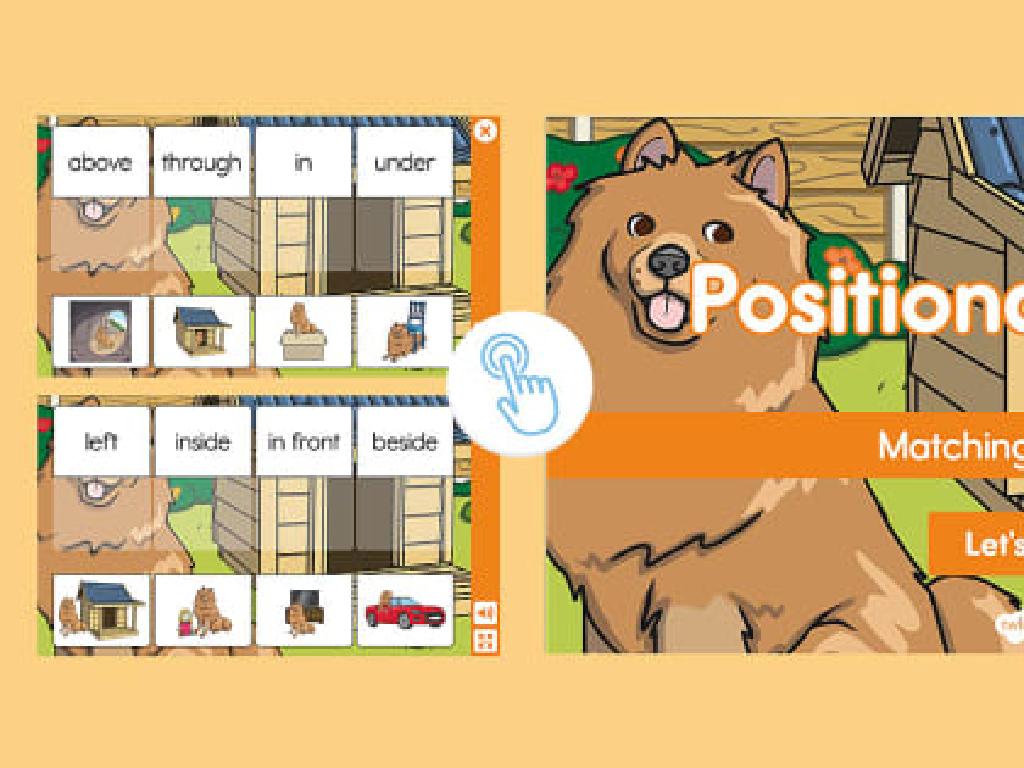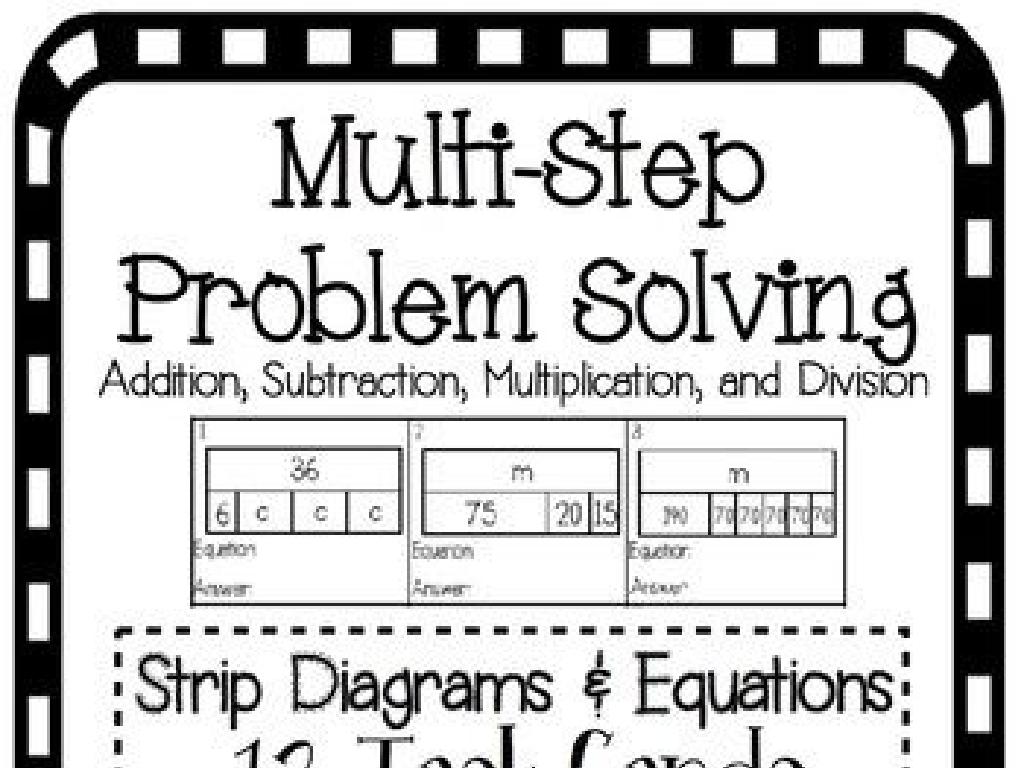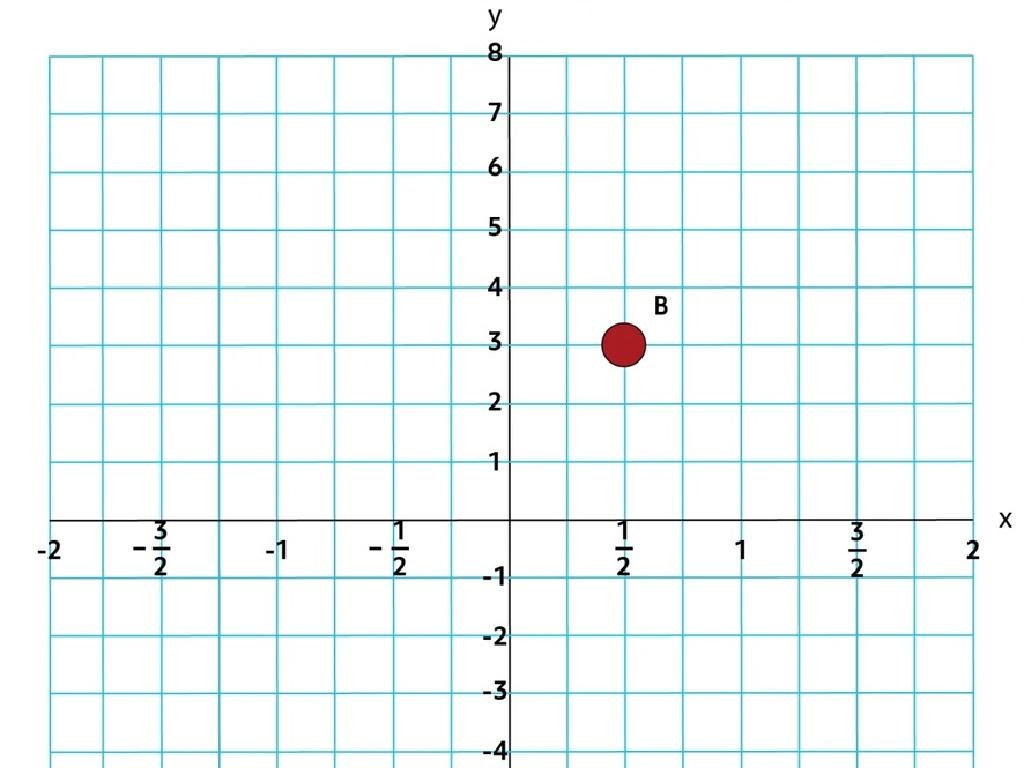Ordinal Numbers - Up To Tenth
Subject: Math
Grade: Pre-k
Topic: Counting To 10
Please LOG IN to download the presentation. Access is available to registered users only.
View More Content
Welcome to Counting!
– Greetings, little learners!
– Today’s fun: ordinal numbers
– Ordinal numbers tell positions: 1st, 2nd, 3rd, up to 10th
– Understanding order with numbers
– Like in a race: who is 1st, 2nd, or 3rd?
– Let’s count to 10 together!
– Practice by counting objects or people in line
|
This slide is designed to introduce Pre-K students to the concept of ordinal numbers in a fun and engaging way. Start by greeting the students warmly to create a welcoming learning environment. Explain that ordinal numbers help us understand the order of things, such as who came first in a race or what position someone is in a line. Encourage the children to count along with you from 1 to 10, using their fingers or objects in the classroom to visualize the numbers. Make sure to emphasize the ‘th’ at the end of each ordinal number, except for 1st, 2nd, and 3rd, which are special cases. The goal is to make the learning experience interactive and enjoyable, setting the stage for a deeper exploration of numbers and their order.
What Are Ordinal Numbers?
– Ordinal numbers show position
– They tell the order of things in a line or list
– First, second, third in a list
– Like in a race or a queue
– Used in daily life
– Birthdays, floors in a building, and more
– Practice with examples
– Let’s order objects and talk about our favorite things!
|
This slide introduces the concept of ordinal numbers to Pre-K students, emphasizing their use in indicating positions such as first, second, and third. Use relatable scenarios like lining up for a turn or ranking in a competition to illustrate the concept. Engage the students with simple daily life examples where ordinal numbers are used, such as identifying the order of finishers in a race or the sequence of people waiting in line. Encourage interactive activities where students can physically arrange items or themselves in order and then describe the order using ordinal numbers. The goal is to make the concept tangible and relatable, ensuring the students can recognize and use ordinal numbers in various contexts.
Learning Ordinal Numbers: 1st to 10th
– What are ordinal numbers?
– Ordinal numbers tell position: 1st (first), 2nd (second), 3rd (third)…
– Ordering with ordinal numbers
– Like in a race: who comes 1st, 2nd, or 3rd?
– Counting 1st to 10th together
– Let’s practice: 1st apple, 2nd apple, up to the 10th apple!
– Using ordinal numbers daily
– When you line up or celebrate birthdays, we use ordinal numbers!
|
This slide introduces Pre-K students to the concept of ordinal numbers, which are used to describe the position of objects in a sequence. Start by explaining that ordinal numbers are different from the numbers they count with because they show ‘order’ or ‘position’. Use relatable examples like positions in a race or the order of students in a line. Engage the class in a fun counting activity where they count objects in order using ordinal numbers. Emphasize the practical use of these numbers in everyday life, such as describing the order of finishers in a race or their place in a queue. Encourage students to think of other situations where they might use ordinal numbers.
Let’s Practice Ordinal Numbers!
– Imagine waiting for the slide
– Are you 1st, 2nd, or 5th in line?
– Practice ordinal places with friends
– Who is standing first? Who is last?
– Understand your position in a queue
– Learning to recognize your turn
|
This slide is designed to engage Pre-K students in a practical activity to understand ordinal numbers. Start by asking them to visualize a common scenario, such as waiting in line for a slide at the playground. Encourage them to think about their position in the line. Use toys or illustrations to demonstrate the concept of being first, second, third, etc., in a queue. Set up a mock line and let each child practice identifying their position using ordinal numbers. This hands-on activity will help solidify their understanding of ordinal numbers in a fun and interactive way. Be prepared with different scenarios or games where students can practice ordinal numbers, such as organizing objects or lining up for a class activity.
Ordinal Numbers in Everyday Life
– Ordinal numbers for dates
– Like 1st for birthdays!
– Order of winners in races
– Who came 1st, 2nd, or 3rd?
– Where else do we see ordinal numbers?
– Think of games or lining up
– Understanding ordinal numbers
– They tell us positions, not quantity
|
This slide aims to show students how ordinal numbers are used in daily life. Start by explaining that ordinal numbers (first, second, third, etc.) are used to describe the position of something in a list, not how many there are. Use a calendar to show how we use ordinal numbers for dates, such as birthdays. Discuss how in a race, ordinal numbers help us understand who finished first, second, third, and so on. Encourage the children to think of other places they have heard or seen ordinal numbers, like when playing games or lining up. This will help them connect the concept of ordinal numbers to familiar experiences. For the activity, you can have students practice by arranging objects or themselves in order and describing their positions using ordinal numbers.
Fun with Ordinal Numbers
– Board games and winning order
– Like in a race, who is 1st, 2nd, or 3rd?
– Stories and event sequences
– ‘First the mouse ran up the clock, then the clock struck one.’ What happened first?
– Play a game to learn ordinals
– We’ll play ‘Ordinal Number Musical Chairs’ to practice.
– Remembering first to tenth
|
This slide introduces ordinal numbers in a fun and interactive way. Use examples from board games to explain how ordinal numbers indicate positions, such as who is in first, second, or third place. Relate ordinal numbers to storytelling by discussing the sequence of events and asking children which event happened first, second, and so on. Engage the class in a game of ‘Ordinal Number Musical Chairs’ where children must find the chair that corresponds to the ordinal number called out. This activity will help reinforce their understanding of ordinal positions from first to tenth. Encourage the children to think of other situations where ordinal numbers are used and to practice saying the ordinal numbers in order.
Class Activity: Ordinal Number Train
– Receive an ordinal number card
– Stand in line based on your number
– Form the Ordinal Number Train
– First, second, third, … up to tenth
– Chug around the classroom in order
– Practice ordinal numbers through movement
|
This activity is designed to help Pre-K students understand and practice ordinal numbers in a fun and engaging way. Each student will be given a card with an ordinal number on it, from ‘first’ to ‘tenth’. They will then have to arrange themselves in the correct order to form a train. Once the train is formed, the class will ‘chug’ around the room in order, reinforcing the concept of ordinal numbers. For the teacher: Prepare ordinal number cards beforehand. Make sure there’s enough space in the classroom for the train to move around safely. You can use train sounds to make the activity more engaging. If the class size is larger than ten, consider having multiple trains or rotating the students so everyone gets a turn. This activity not only teaches ordinal numbers but also helps with listening skills and following directions.
Review and Goodbye!
– Recap ordinal numbers up to tenth
– Identify the third number
– Which one is third in a race?
– Recognize the first number
– Who stands at the start of the line?
– Celebrate learning about numbers
|
This slide is meant to conclude the lesson on ordinal numbers by reviewing what the students have learned. Start by recapping ordinal numbers from first to tenth. Ask the students to identify which number is third by giving them a scenario, such as a race or a queue, where they can visually imagine the position. Similarly, ask them to recognize the first number. Praise their efforts and remind them that understanding numbers is not only fun but also very useful in everyday life. Encourage them to look for ordinal numbers in their surroundings, like in sports positions, lining up, or even chapters in a book.





